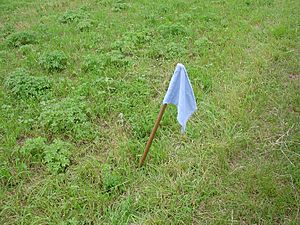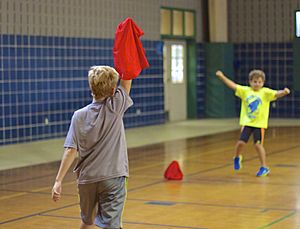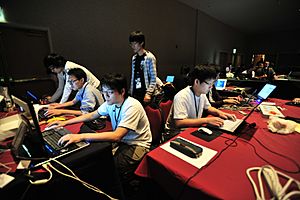Capture the flag facts for kids

An uncaptured flag
|
|
| Players | Large group, more than six players in a team |
|---|---|
| Playing time | 10–30 minutes |
| Skill(s) required |
|
| Synonym(s) | CTF |
Capture the Flag (often called CTF) is a fun outdoor game. Two or more teams try to grab a special item, called a "flag," from the other team's home base. The goal is to bring the enemy's flag back to your own base safely. If an enemy player tags you in their territory, you might be out of the game, sent to "jail," or sent back to your own side.
Contents
How to Play Capture the Flag
Capture the Flag needs a playing area, like a park or a big yard. This area is split into two clear halves, called "territories." Each team has its own territory. Every team also has a "flag." This is usually a piece of fabric, but it can be anything easy to carry. For night games, players might use flashlights or glowsticks as flags. Some teams wear dark clothes at night to be harder to see.
The main goal is to run into the other team's territory, grab their flag, and bring it back to your own side without being tagged. Players defend their flag by tagging opponents who try to take it. When you are in your own territory, you are "safe" and cannot be tagged. But once you cross into the enemy's territory, you can be tagged.
The rules for Capture the Flag were first written down in 1908. They appeared in a book called "Scouting For Boys" by Robert Baden-Powell, who started the Scouting Movement.
The flag is usually placed where everyone can see it at the back of a team's territory. Sometimes, the flag is hidden in a tricky spot. For example, it might be high up in a tree, and players have to knock it down to get it.
What Happens if You're Tagged?
Different versions of Capture the Flag have different rules for tagged players. If you get tagged, you might be:
- Out of the game completely.
- Forced to join the other team.
- Sent back to your own territory.
- Sent to "jail."
Jail is a special area in the enemy's territory where tagged players wait. It's usually near the back of their side.
Jailbreak!
In many games, players stay in jail until a teammate frees them. This is called a "jailbreak." A teammate runs from their own territory into the enemy's jail. Depending on the rules, they might free everyone in jail, or just the players they touch. Once freed, players usually have to go straight back to their own territory before they can try to get the flag again. While returning, freed players are often "safe" from being tagged.
The player who performs the jailbreak is not safe. They can still be tagged. They can also try to grab the flag or move around the enemy territory. Sometimes, players in jail can hold hands to form a chain. If a teammate tags one person in the chain, everyone in the chain is freed! Leaving jail without being freed is not allowed and is seen as unfair. If all players on one team are in jail, the other team can easily find and capture their flag.
Winning the Game
The rules for handling the flag also change from game to game. If a player is tagged while carrying the flag, it might go back to its starting spot. Or, it might stay where the player was tagged. This second rule makes it easier for the attacking team, as the flag slowly moves closer to the middle of the field. In some games, players can throw the flag to teammates. As long as the flag doesn't hit the ground, passing is allowed.
When a player captures the flag, they are usually not safe from being tagged until they reach their own territory. In most versions, the flag carrier cannot throw the flag, only hand it off to a teammate while running. The game ends when a player brings the enemy flag back to their own territory. Usually, the flag carrier cannot free teammates from jail.
Different Ways to Play
There are many fun ways to change the game:
- One Flag CTF: Only one flag is used. One team defends it, and the other team tries to capture it.
- Multiple Flags: Some games use three or more flags. To win, a team must capture all of them, not just one.
- Bandanna Version: Players wear bandannas sticking out of their pockets. Instead of tagging, you pull an opponent's bandanna. If your bandanna is pulled, you are captured and must go to jail or return to your base. In this version, there are no territories, just a small base for each team's flag. The first team to have both flags in their base wins.
- Indoor Urban Play: This version is played indoors in an area with walls, like a hockey rink. Players can legally check each other, similar to hockey. If a player breaks a rule, they go to a penalty box for a short time. Throwing the flag is allowed, but it must be caught before it hits the ground.
- Glow-in-the-Dark: A cool version called Capture the Flag REDUX uses glowing orbs as flags. Players wear glowing bracelets to show their teams, and jail areas also glow.
- Airsoft, Paintball, or Nerf: People often play CTF with airsoft guns, paintball guns, or Nerf blasters. In these games, there are usually no territories. If you get "hit," you sit out for a set time before rejoining the game.
Stealing Sticks
"Stealing sticks" is a similar game played in many countries. Instead of a flag, teams have a pile of sticks (or coats or hats) in a "goal" area. Just like in Capture the Flag, players go to "prison" if tagged in the enemy's area and can be freed by teammates. Each player can only take one stick at a time. The first team to take all of the opponent's sticks to their own side wins.
Capture the Flag in Computers
The idea of Capture the Flag is also used in computer games and even in computer security challenges.
Computer Security CTF
In computer security Capture the Flag, "flags" are secret pieces of information hidden in computer programs or websites that have weaknesses. Players try to find and "steal" these flags. This can be done by finding bugs in the programs or by trying to hack into other teams' computers.
These security CTF games are great for learning. They teach people how to protect computers and how to find weaknesses, just like real-world bug bounty programs. Players learn skills like:
- Reverse-engineering: Figuring out how a program works backward.
- Network sniffing: Looking at data moving across a computer network.
- Programming: Writing code to solve problems.
- Cryptanalysis: Breaking secret codes.
- Exploits: Finding ways to use weaknesses in programs.
In some security CTF games, each team gets a computer to defend. They earn points for protecting their own computer and for attacking other teams' computers. Other games are more like puzzles, where teams solve challenges set by the organizers to find the flags.
Urban Gaming
Capture the Flag has become popular again with adults as part of "urban gaming." These games are played in city streets. Players use cellphones to talk to each other. News about these games spreads online through blogs and email lists. Urban Capture the Flag is played in many cities, often with large groups of people.
Images for kids
See also
 In Spanish: Capturar la bandera para niños
In Spanish: Capturar la bandera para niños





